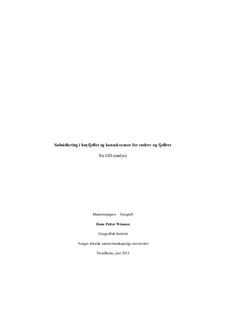Subsidiering i høyfjellet og konsekvenser for rødrev og fjellrev: En GIS-analyse
Master thesis

View/
Date
2011Metadata
Show full item recordCollections
- Institutt for geografi [1097]
Abstract
The arctic fox has been listed as endangered species since 1930 in Norway, but the numbersof arctic fox has continued to decline through the 20th century and into the new century. Many biologists blame this on the slightly bigger red fox which extrudes the smaller arctic fox from the small suitable mountain areas which still remains in Norway. One of the reasons for this is that the red fox is able to utilize a larger number of food sources than before, mainly garbage and other food sources which exists as a result of human impact on nature. This thesis tries to map the spatial distribution of subsidization in and around three national parks (Hardangervidda, Dovrefjell-Sunndalsfjella and Børgefjell) in Norway by using multi-criteria decision analysis within a GIS.
Findings in this thesis show that Hardangervidda has a substantial amount of subsidization,especially compared to the two other areas. Børgefjell is the area which is least impacted of human-induced changes, and my estimates show that it’s the area with the least amount of subsidization. Subsidization in Hardangervidda might be one of the reasons why the arctic fox was extruded from this area, as distance between subsidization zones and red fox dens are small. The distance between subsidization zones and arctic fox dens at Børgefjell is longer and this might explain why Børgefjell is the only national park on mainland Norway with breeding arctic foxes.